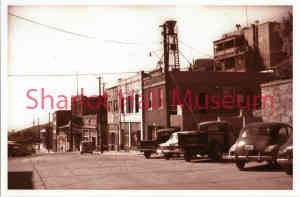Jerome, Arizona
details
Arthur A. Hunt Unknown 1200.0417.0001.jpg CI-TN-0417 Sepia 1200-0417-0001 1200.0417.0001 Print 8x10 Historic Photographs 1940s - 1950s Reproduction requires permission. Digital images property of SHM Library & ArchivesDescription
Jerome, like many other Arizona towns, was born with the discovery of rich ore deposits in its vicinity. Before Europeans arrived, Native Americans “mined” the mineral deposits of the area for pigments. Early Spanish and American explorers recognized the mineral deposits in the area, but it was not until the late 1870s that the first mining claims were filed. Minimal development work was done until transportation difficulties were somewhat resolved with development of rail lines from the Atchison, Topeka and Santa Fe main line to Prescott in 1887 and 1893. In 1887, William A. Clark, a prosperous miner and entrepreneur (and later senator) from Butte, Montana, purchased some of the small mining properties and began large scale mining operations. Four major fires in 1894 to 1899 devastated the downtown area, but could not destroy the underlying wealth. The rich copper ore deposits turned Jerome into a boom town; by 1929 the population had grown to an estimated 15,000. Clark's United Verde Copper Company and James "Rawhide Jimmy" Douglas' Verde Extension mines produced millions of dollars worth of copper, and enough gold and silver to pay much of the operating expenses. With prosperity came the usual influx of profiteers and Jerome was labeled as the wickedest town in America by the New York Sun newspaper. In 1935, Phelps Dodge Corporation purchased the United Verde property and continued operating it until 1953 when the last of the mines shut down. Jerome seemed doomed as the population dropped to less than 100. But a new breed of settlers slowly moved in and the town became a modern age tourist attraction and haven for artists, environmentalists, bikers, retirees and more.
Purchase
To purchase this image please click on the NOTIFY US button and we will contact you with details
The process for online purchase of usage rights to this digital image is under development. To order this image, CLICK HERE to send an email request for details. Refer to the ‘Usage Terms & Conditions’ page for specific information. A signed “Permission for Use” contract must be completed and returned. Written permission from Sharlot Hall Museum is required to publish, display, or reproduce in any form whatsoever, including all types of electronic media including, but not limited to online sources, websites, Facebook Twitter, or eBooks. Digital files of images, text, sound or audio/visual recordings, or moving images remain the property of Sharlot Hall Museum, and may not be copied, modified, redistributed, resold nor deposited with another institution. Sharlot Hall Museum reserves the right to refuse reproduction of any of its materials, and to impose such conditions as it may deem appropriate. For certain scenarios, the price for personal usage of the digital content is minimal; CLICK HERE to download the specific form for personal usage. For additional information, contact the Museum Library & Archives at 928-445-3122 ext. 14 or email: orderdesk@sharlot.org.




